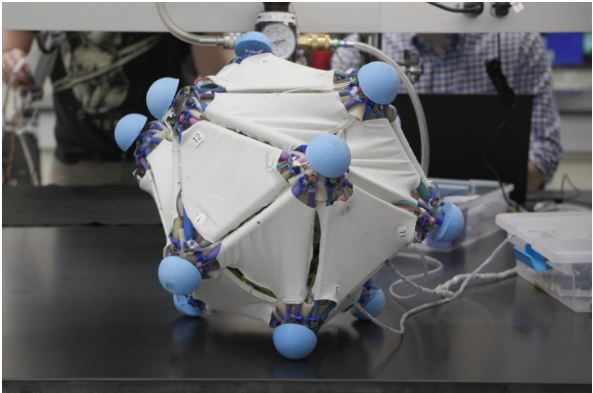Getting Comfortable With Soft Robotics

New Robotic Skins technology developed by Yale researchers allows users to turn everyday objects into robots. (Photo courtesy Yale University)
By Sunny Lewis
NEW HAVEN, Connecticut, September 20, 2018 (Maximpact.com News) – Search-and-rescue robots that act without risk to first responders, a robotic gripper that grasps and moves objects – these applications and many more just moved closer to reality with the development of a new technology in a Yale University lab.
Called Robotic Skins, the technology lets users turn everyday soft objects into robots and design their own robotic systems.
The Robotic Skins were created in the lab of Rebecca Kramer-Bottiglio, assistant professor of mechanical engineering and materials science at Yale.
The skins are made from elastic sheets embedded with sensors and actuators. Placed on a soft object such as a stuffed animal or a foam tube, the skins animate it from the surface.
The robots can do different tasks depending on the properties of the soft objects and how the skins are applied.
WATCH VIDEO:
“We can take the skins and wrap them around one object to perform a task, locomotion, for example, and then take them off and put them on a different object to perform a different task, such as grasping and moving an object,” explained Kramer-Bottiglio.
“We can then take those same skins off that object and put them on a shirt to make an active wearable device,” she said.
With the robotic skins on board, said the Yale scientist, anything from a balloon to a ball of crumpled paper could potentially be made into a robot with a purpose.
In the past, robots have been built to serve a single purpose.
Now the robotic skins allow users to create multi-functional robots on the fly. Kramer-Bottiglio says that means they can be used in settings that hadn’t even been considered when they were designed.
Piling on the skins in layers allows for more complex movements and different types of motion.
“Now we can get combined modes of actuation – for example, simultaneous compression and bending,” Kramer-Bottiglio said.
To demonstrate the robotic skins in action, the researchers created prototypes – foam cylinders that move like an inchworm, a shirt-like wearable device designed to correct poor posture, and a device with a gripper that can grasp and move objects.

Rebecca Kramer-Bottiglio, assistant professor of mechanical engineering and materials science at Yale, 2018 (Screengrab from video courtesy Yale University)
Kramer-Bottiglio said she came up with the idea for the devices a few years ago when the U.S. National Aeronautics and Space Administration (NASA) issued a call for soft robotic systems.
The technology was designed in partnership with NASA.
The multifunctional and reusable nature could allow astronauts to accomplish an array of tasks with the same reconfigurable material.
The same skins used to make a robotic arm out of a piece of foam could be removed and reapplied to create a soft Mars rover that could roll over rough terrain.
“One of the main things I considered was the importance of multifunctionality, especially for deep space exploration where the environment is unpredictable,” said Kramer-Bottiglio. “The question is: How do you prepare for the unknown unknowns?”
The team’s work was published Wednesday in the journal “Science Robotics.”
Next, said Kramer-Bottiglio, her lab will work on streamlining the devices and will explore the possibility of 3D printing the components.
In other soft robotics research, Kramer-Bottiglio is planning “to realize deployable self-constructing robots (bagbots) based on robotic skins that ingest and manipulate material.”
“Bagbots are optimal for exploration of unknown environments, which directly contributes to NASA’s strategic goal to expand human knowledge through scientific discoveries,” she writes.
A bagbot can be transported as a lightweight system, but later can self-construct a body made from clay or other surface materials.
For her work with soft robotics, Kramer-Bottiglio was in May part of a group of researchers awarded a $2 million grant from the National Science Foundation, as part of its Emerging Frontiers in Research and Innovation program.
Titled “Soft Robotics to Broaden the STEM Pipeline,” this project aims to increase female interest in science, technology, engineering and mathematics (STEM) careers through the emerging field of soft robotics.
“Soft robotics are different from other robotics in that they leverage materials science (understanding how materials stretch and deform), chemistry (polymer synthesis), and biology (bio-inspired design) to provide aids for human needs,” write the four co-authors in their summary of the project.
The focus is an eight-hour unit within a high school freshman engineering course that is taught in over 270 school districts across 23 states to about 100,000 students annually.
The project will test the idea that soft robot design experiences improve learning, motivation, engineering self-efficacy and interest in engineering careers as compared to traditional robot design experiences.
For this project, Kramer-Bottiglio is joined by Nathan Mentzer, associate professor Engineering/Technology Education at Purdue University, and two others. Together they will develop and test curriculum that has the potential to broaden female participation in robotics in 11 classrooms, a total of 660 students in Maryland’s Carroll County Public Schools.
Once it is complete, the International Technology and Engineering Educators Association STEM Center for Teaching and Learning will distribute the curriculum to 50,000 students every year.